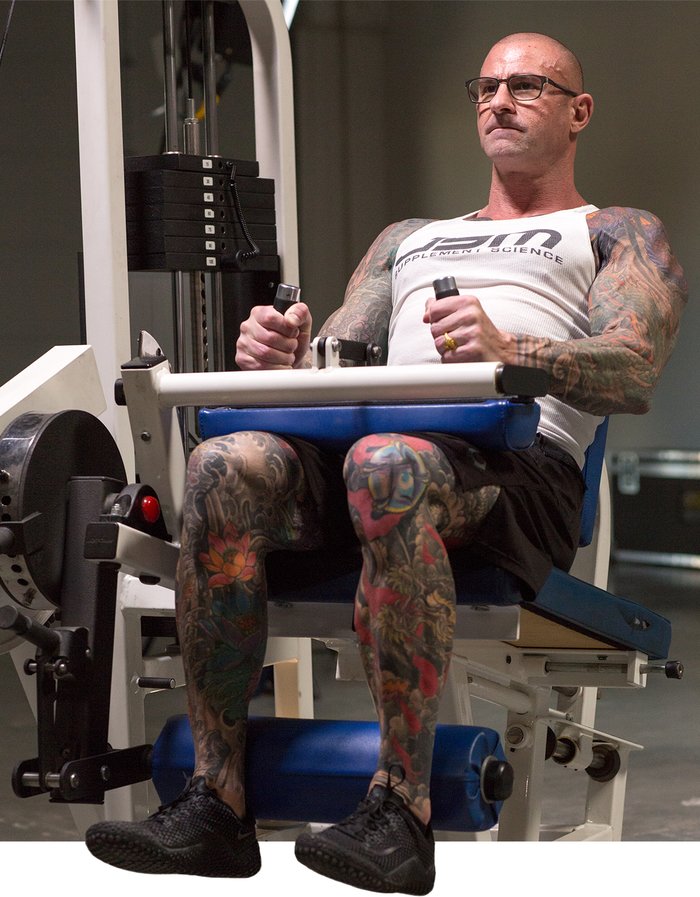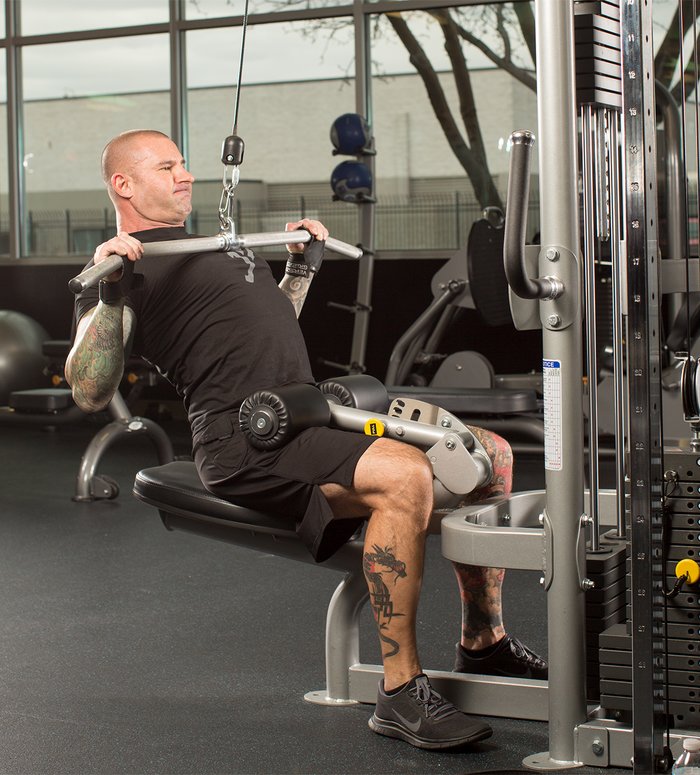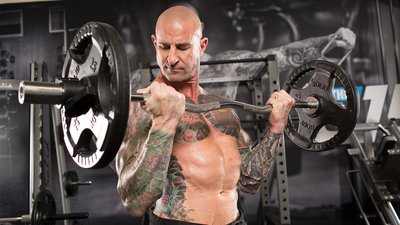One letter can make a big difference. No, this is not another HIIT cardio article. Drop one of the I's, and that's what we're talking about here: H.I.T., or high-intensity training.
With my recent Full-Body Giant-Set Program routines, I showed you a high-volume way to hit each major muscle group in every full-body workout. You were essentially doing four exercises for four total sets per muscle group each time. This approach could classify as high-volume training, especially if you performed it for 7 days straight, like I did on my Facebook page.
H.I.T., on the other hand, is built around lower volume and higher intensity. On a per-workout basis, you're hitting just about the minimum amount of volume possible for each muscle group: one warm-up set, and one working set. That's it.
But here's the rub: The one working set isn't a typical straight set. It's a multiple-times-to-failure, drop-setting, rest-pausing, all-out muscle-burning barrage. Once the set's over, you're done with that muscle group—and you know it!
H.I.T. is great for promoting muscle mass and strength, and also sparking fat loss. It just does so via super high intensity, not volume. When fueled with proper nutrition and supplements, high intensity can equal fast results. If you're short on time but still want to get in a brief yet effective muscle-building workout, this could be right up your ally.

H.I.T History
H.I.T. was first popularized decades ago by Arthur Jones, the founder of Nautilus, and reached the training mainstream with help from the late, great pro bodybuilder Mike Mentzer. Other bodybuilders who saw great results from this training method include Casey Viator, Lee Labrada, and of course, Dorian Yates.
Here's the essence of it, and how you'll be performing it if you follow my workouts:
Intensity: Although many H.I.T. followers use very heavy weight and low reps, H.I.T. isn't just about the weight used, but about training beyond the point of absolute muscle failure. Every set must be taken beyond failure for the technique to work. This requires the use of advanced training techniques. With my H.I.T. protocol, these techniques include dropsets, rest-pauses, and either cheat reps or forced reps.
Volume: The reason H.I.T. calls for only one working set—instead of, say, 2-3 sets—per exercise is simple: If multiple sets of an exercise are performed, every set can't be trained with maximum intensity. By doing one, and only one, working set of an exercise, you have a better chance of training with maximum intensity on every working set.
Frequency: Another element of H.I.T. that Mentzer, Yates, et al., subscribed to was low frequency. In their interpretation, this meant training every muscle group no more than one day per week to allow for adequate recovery from the brutally intense working sets.
My version of H.I.T. involves full-body workouts—up to five of them per week. So obviously, I'm violating the low frequency H.I.T. law. But consider these factors:
- When Yates, for example, did H.I.T. workouts, he did multiple exercises for each body part every session; in my version, you're only doing one exercise per muscle group per workout.
- Yates also did more than just one warm-up set for the first exercise or two per body part—typically 2-3 warm-ups set. And his warm-up sets weren't always easy; in fact, most of Yates' warm-up sets would have been considered challenging working sets for the average gym goer. In my H.I.T. workouts, the one warm-up set is truly an easy priming set.

H.I.T. Science
There's no research to specifically support the theory of H.I.T. However, the logic that underlies it is sensible. Basically, it relies on muscle growth through the mechanism of muscle damage and regeneration.
Although science still knows little about precisely how muscles grow, there are two plausible theories that seem to both contribute to muscle growth. The first mechanism involves damaging the structure of a muscle cell with mechanical stress, such as heavy weight. In response, the damaged muscle cells kick off a regeneration process that ends up with newer, stronger muscle cells replacing the damaged ones.
Anecdotal reports from bodybuilders who have used H.I.T. training are varied. Some report considerable gains in both size and strength. But for many, the initial progress soon comes to a halt. The reason some have failed with H.I.T. training is likely due to the one problem that all training programs have: If you follow it for too long, your progress is likely to come to a screeching halt.
Instead of sticking with just one training philosophy, like H.I.T., I recommend embracing a plethora of training programs, and cycling them frequently. This is precisely why I've been feeding you a new training technique every week on Bodybuilding.com. Here's what we've gone through so far:
Hit the H.I.T. Blitz for a week, like I'll be doing myself and showing you on my Facebook page over the next five days, then move on to my next featured technique and accompanying program. (Spoiler alert: That next technique might involve the number 100, so stay tuned.)
Stoppani-Style H.I.T: The Details
The H.I.T. protocol that I'm outlining here can be performed up to five days a week. In each workout, you'll train all major muscle groups:
- Chest
- Back
- Legs
- Shoulders
- Traps
- Triceps
- Biceps
- Forearms
- Calves
- Abs
That's the order I'll typically train them, as well.
Time-saving tip: If you're on a tight schedule and need to shorten the workout, feel free to drop one or more of the smaller body parts, such as traps, forearms, calves, or abs.
As I mentioned earlier, you'll do one exercise per muscle group, with one warm-up set and one working set for each exercise. Here's exactly how those sets will look:
Warm-Up Set
Using 50 percent of your estimated 3-6 rep max, do anywhere from 5-7 reps, stopping well short of failure. Keep in mind that the goal here is activation, not hard work. Rest 1 minute or so, then move on to your working set.

Working Set
- Using your 3-6 rep max, rep out to failure between 3 and 6 reps.
- Rest 10-20 seconds, then pick up that weight again and go to failure. This is a rest-pause set.
- Immediately lighten the load to your warm-up weight, 50 percent of 3-6 rep max, and go to failure again. This is a dropset.
- Rest 10-20 seconds, then pick up that lighter weight again and go to failure—another rest-pause set.
- Without resting, finish the set with either 2-3 cheat reps—allowing a little "body English" to help you get a few more reps—or forced reps, having a partner help you get 2-3 more reps after reaching failure. If you're training alone but doing a one-arm dumbbell exercise, you can also use your non-working hand to help you get the forced reps.
You're done with that exercise. Rest 1-2 minutes, or as little as you like, and move on to the next muscle group.
Exercise Selection
You can use virtually any exercise for H.I.T.: compound (multijoint) exercise, single-joint moves, free weights, machines, cables—you name it. In my experience, machines work well for these H.I.T. workouts, because they're usually conducive to both dropsets, where decreasing weight is a simple matter of moving the pin up the stack; and rest-pauses, because you can quickly and easily rack the weight, rest briefly, then pick it back up.
Consider changing up the muscle group focus from one workout to the next. For example, if you did wide-grip lat pull-downs in workout one, which target the upper lat muscle fibers and teres major, you could do an exercise that better targets the lower lats, like reverse-grip rows, in the next workout.
In the workouts I'll show you on social media in the coming days, I'll be using a variety of different exercises and equipment within the H.I.T. protocol. This should give you a pretty good idea of what moves will be most conducive for effective H.I.T. workouts.
Consider today an off day before I start unveiling my H.I.T. workouts on Facebook tomorrow. You'll need the rest before the intensity blitz starts!
Visit JimStoppani.com for more workouts, training tips, and articles on nutrition and supplementation.

